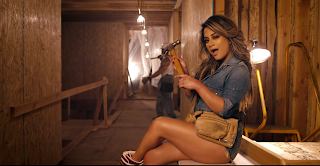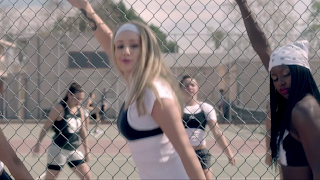"Dancing in the Distraction Factory" - Andrew Goodwin's music theory - THERE ARE 7 POINTS TO CONSIDER:
- ALL music videos have certain genre characteristics depending on the music genre.
- Relationship between the visuals and lyrics
- Shown more often than NOT often.
- Demand of record label evident in the video
- Artist iconography.
- "Notion" of looking (actors and artist will "look" at the audience).
- The music video should be intertextual.
"Dancing in the Distraction Factory: Music, Television and Popular Culture" was a media-based book published in 1992.
- The theory was that music videos were often constructed by a relationship between visuals, song and artist.
- There is a series of codes and conventions for music videos that many of them have in common; they are noted above.
Goodwin suggested that there is a link between the genre of music and the genre visuals of music videos.
...meaning that the visuals of the music video will be constructed and styled to match the genre of music being played. Say, for example,
Mac DeMarco's "Passing Out Pieces":
- Since the song is classified as jangle pop/psychedelic pop, the visuals are represented as colourful and flamboyant, which links both visuals and genre of music together.
- The actors portrayed only have ordinary clothing meant to represent an indie fashion and the melodic tone of music reflecting a simple lifestyle but telling a story at the same time.
- The lighting visually represents the jangle pop/psychedelia tone of "Passing Out Pieces". Also reflects Mac DeMarco's style of his music videos - weird, wonderful, filmed from a peephole-style camera view. The mise-en-scene of the video gives a psychedelic feel (especially the lettuces involved) matching the respective genre of music.
- Mac's scruffy hair gives a dirty indie feel. He bathes in a "lettuce bath" which can be seen as an element of deviation from normal society. Does not conform to the norms of living an ordinary life.
Blur "Song 2"
Enter Shikari "Sorry You're Not a Winner"
The music video was filmed in 2006. It has the codes and conventions of a typical rock music video:There is no narrative to the song and band. The band are shown playing live in front of a small crowd - in the video, a wide performance shot is shown: a typical convention of rock music. At the 2:04 mark, the pace slows down and the lighting becomes dim, with an illumination of green. The lighting returns when the guitars are played to signify a live gig being played.
The Hunna's "Bonfire" also includes some of the typical codes and conventions of the alternative rock music genre.
Album "100" releasing on 26 August.
More often than not there is a relationship between the visuals and the lyrics
In most music videos the lyrics are represented with visual IMAGES.
...which means that they either amplify, illustrate or contradict the lyrics.
Mike Posner "I Took a Pill In Ibiza (SeeB Remix)" from "At Night, Alone.":
"I took a pill in Ibiza / To show Avicii I was cool"
The setting is of a party atmosphere with flamboyant crowds and dim visuals. BEFORE Posner sings, however, he takes the aforementioned pill, then becoming the character we see in the second screenshot. All he wants is to show off to those partying in the video, potentially meeting nearby gorgeous women around him.
"You don't wanna be high like me / Never really knowing why like me"
Despite Posner experiencing the positive effects of taking the party drug, he never really gets indulgent in dancing with the partygoers alongside him. The "fame" he is into is actually a complex rollercoaster. He isn't really recognised by anyone else in the video.
"You don't wanna be stuck up on stage singing / Stuck up on that stage singing / All I know are sad songs, sad songs"
Coincidentally, Posner is on stage with his acoustic guitar, about to perform in front of the crowd, alone. He is not like a disco DJ who can pick any song from the music database - instead limited to playing songs on his guitar.
"AT NIGHT, ALONE"
Those are examples of visually illustrative lyrics in mainstream music videos.
Lonely the Brave "Rattlesnakes":
There is a relationship between the music and the music video
Lonely the Brave's "The Blue, The Green":
The tone and atmosphere of the visuals MUST reflect that of the respective song.
In "The Blue, The Green":
The music video visualises the final days of a cancer sufferer. He longs to make the most of his time enjoying the last moments of his life with his long-term friend before he dies. The tone of the song reflects the poignant atmosphere of the video, because it is telling a story.
"The Blue, The Green" is a slow-moving, melodic alternative rock piece which proves emotional with this music video - which means that the atmosphere and mise-en-scene relates to the song's melody.
The demand of the record label will be evident in the video
Fifth Harmony "Work from Home (feat. Ty Dolla $ign)"
Formed in July 2012 during the second season of The X Factor USA, Fifth Harmony is a five-piece American girl group who came third on the show. They have signed a joint deal with Syco Music, Simon Cowell's record label, and Epic Records, L.A. Reid's record label. Both Cowell and Reid are judges on the X Factor USA. They are a young girl group; Ally is aged 22 while Normani is aged 20 and Lauren is aged 20. Camila is aged 19 while Dinah Jane is aged 19 - teenage performers.
The record labels, Syco Music and Epic Records, have a certain amount of control over their signed artist/s.
It is up to them how the artist/band is represented. Say for example, in Fifth Harmony's "Work from Home", the male models (dressed as workers) are represented as muscular, tanned and attractive, as shown in the media. This shows off the stereotypical expectations of a young man in the modern world.
The setting of the music video in "Work from Home" is chosen as a typical building site, complete with blueprints, hammers, pneumatic drills and even a real digger on site. This mise-en-scene, complete with the gym-clad builder outfits, appear to correlate to the title of the song - Work from Home.
There are many close ups of the singers in Fifth Harmony. For example Dinah Jane Hansen as shown in the image above. Close ups are personal so as to connect the audience with the artist and make them feel like they share a relationship with the artist. They play a part in selling the artist, which is a vital need for the record label.
Fifth Harmony are shown dancing in provocative ways whilst wearing sexually attractive outfits (including thigh-baring shorts), which sets up a stereotypical expectation of young teenage girls today - to be more attractive to men.
This is a motif created by record labels which recur throughout their work in order to sell famous artists to the public and earn thousands of pounds that way.
Ty Dolla $ign is the featured rapper alongside Fifth Harmony. Many famous musical artists collaborate with other artists to raise audience appeal and profits.
BUT BACK TO MY PREFERRED STYLE OF GENRE...
Max Raptor "The King is Dead"
This music video contains close ups of the lead singer.
Artist iconography
This ensures that musical artists are dressed in a particular fashion throughout their range of music videos.
Fetty Wap ("Fetty" for money, "Wap" as a tribute to Gucci Mane's stage name GuWop).
Willie Maxwell was born with congenital glaucoma in both eyes but doctors couldn't save his left eye from being fully damaged. In his music videos he is represented as wearing colourful outfits and flamboyant hairstyles. As the "Fetty" part of his stage name means money, he is shown to wear golden bling which reinforces money and fame. His left eye has now become an iconic symbol which causes his audience to easily recognise him.
His damaged left eye, however, does not affect his overall performance as he still shows his outgoing dance style, as shown above in "Wake Up". He dresses up that way to mark his current fame to audiences.
Artists dressing up in a particular fashion have their star factor increased, which can play a part in the production process of music videos, which creates an audience icon where they are universally recognised by audiences.
THE NOTION OF LOOKING
Popular music videos demand the audience to be voyeuristic.
This sense of sexual behaviour is utilised to increase the attractiveness of the video (especially to appeal to males).
As shown in the music video for Iggy Azalea's "Fancy (feat. Charli XCX) [Explicit]":
Iggy Azalea's "Fancy" depicts the artists dancing provocatively in a "pop style" dance, so as to attract audiences. On YouTube, the music video for "Fancy" has gained a total of 743,096,341 views due to this.
The notion of enticing the audience into watching the artists act in the video easily helps to sell the music of artists through the art of voyeurism.
As said by Andrew Goodwin: females will be objectified, often through a combination of camerawork and editing. Fragmented body shots will emphasise sexual treatment of the performer(s).
This is also represented in the music video for Fifth Harmony's
"Work from Home"
Voyeurism is also represented through watching something happen from the point of view of an observer in the video.
MEANWHILE, BACK AT IT WITH MY PREFERRED GENRE...
Editors "Munich":
INTERTEXTUAL
This music video technique brings in other types of media:
TV, film, animation, etc.
Linkin Park "Iridescent" from Transformers: Dark of the Moon and from "A Thousand Suns"
In this music video, elements from "Transformers: Dark of the Moon" including Decepticon ships as well as the robotic characters from the movie (ex. Sentinel Prime, Bumblebee, Megatron) are used in order to establish Linkin Park's musical interconnection with the Transformers movie universe.





















No comments:
Post a Comment